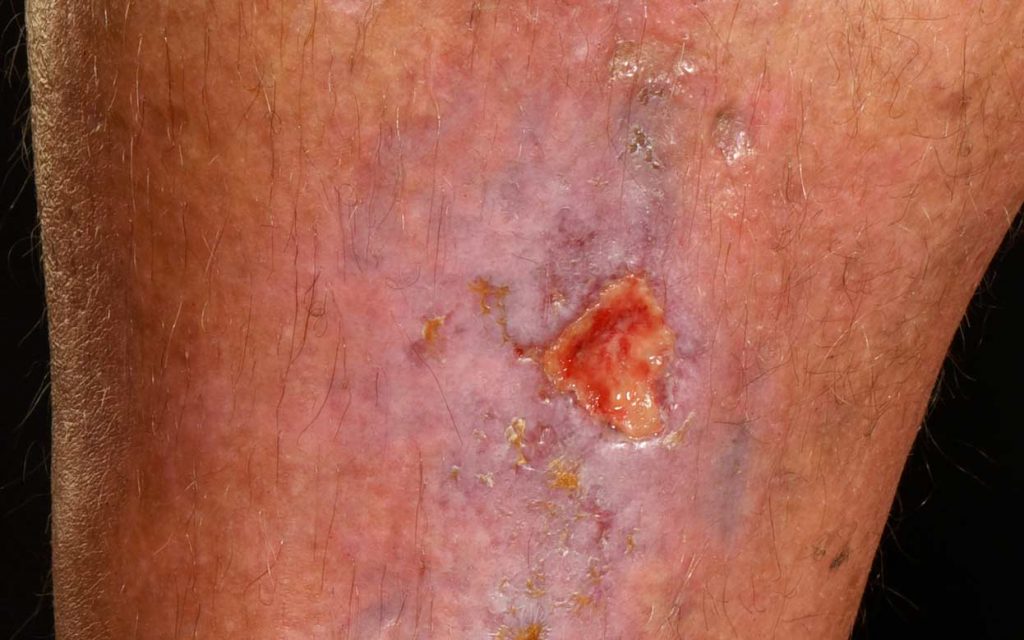Managing your leg ulcer at home
This information is for people who already have a leg ulcer or foot ulcer and need help or support looking after their wound or changing dressings at home. This may also be helpful for carers, friends or family members.
What are leg ulcers or foot ulcers?
You may have been diagnosed with a leg or foot ulcer which is a wound, usually below the knee on the leg or foot, which has been there for more than 2 weeks. This wound may have occurred as a result of a trauma to your lower limb (accidentally hitting your leg on something or from a fall).
The wound will normally have a dressing which will need changing at least weekly but sometimes more often if the wound is leaking a lot of fluid (exudate).
Preparing to change a dressing, monitoring pain and measuring your wound are all areas covered in this video from Accelerate. The more you know about your wound the better the conversation you can have with your nurse or healthcare professional.
Image ©Mid Yorks NHS Teaching Trust
How do I know if my leg ulcer is not healing?
- Have you noticed any increase or decrease in pain?
- Has there been an increase or decrease in the amount of fluid coming from the wound site?
- Can the fluid be contained within the dressing?
- What colour is the tissue in the wound bed?
Pink – healthy sign showing that new skin is beginning to cover the surface
Red – healthy new red tissue tissue is filling the wound
Yellow – this can be a sign that could lead to a delay in wound healing
Black – this needs to be assisted to lift away from the wound to enable the new, healthy tissue to grow
- Can you see if the wound is getting smaller or larger? Compare with an object of a similar size and record any increase or decrease.
If you have concerns with any of the above, please get in touch with your healthcare professional for advice.
Leg washing and wound dressings – home application and treatment
Part of the secret to getting this done well, is to prepare everything before you start. You will need:
- A bowl which is large enough to fit your foot in filled with clean, warm water
- A dressing pack and gloves
- Non scented moisturiser or emollient cream. Remember if you have been advised to use a steroid cream you should apply this as you have been previously directed by your nurse or specialist
Once you have everything together and you are ready to change your dressing, first watch the film below, which takes you through the whole process.
We would like to thank Alison Schofield for making this short video available to us.
Please remember that a dressing can stay in place for up to 7 days unless it becomes loose, leaks or becomes uncomfortable.
What to look our for when applying compression bandaging, wrap systems or hosiery
If you’re using a wrap system, wear supportive stockings or tights (hosiery) or use compression bandaging (compression bandaging is normally only applied by your nurse or healthcare professional, here are some things to look out for:
- Does your footwear still fit the same – if your footwear is tight it may mean that the swelling has increased?
- Does the bandaging, wrap or hosiery feel firm and supportive?
- Is your skin red and inflamed?
- Is your skin dry and flaky?
- Is your skin white and soggy – like you’ve just come out of the bath?
- Do you have eczema or another skin condition that requires specific creams or ointments?
If you have concerns with any of the above, please get in touch with your healthcare professional for advice.
Wrap systems – home application and treatment
A wrap system is a garment which you can wrap around your lower leg, thigh or foot to create compression. We’ve previously mentioned the importance of compression – this squeezes your leg tighter to help it heal. Wraps often have markers to guide you as to the degree you need to tighten them.
Things to remember:
- If you don’t put your wrap on to the level of compression you need to have, it will not help the healing process for your wound
- If the wrap loosens as you move around during the day, you should tighten it to the level needed
The following video shows how to successfully apply and remove a wrap system.
Stockings or socks (hosiery) – home application and treatment
If you’ve been prescribed stockings or socks (hosiery), you will know that putting them on requires a little bit of skill and a lot of patience. It takes time to learn how to do this well and if you’re struggling please do not give up.
If you find it difficult to apply, there are application aids which can be made available for you. Here are the makes of some of the aids, please speak to your Nurse at Accelerate.
Our video below demonstrates a selection of hosiery aids for both application and removal.